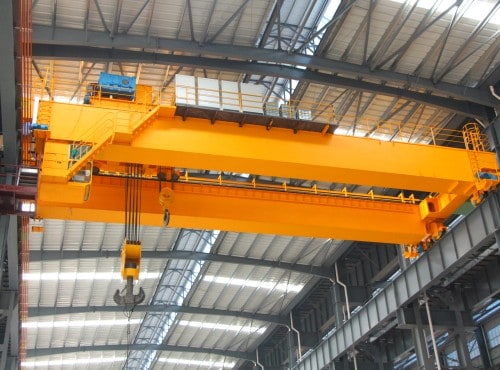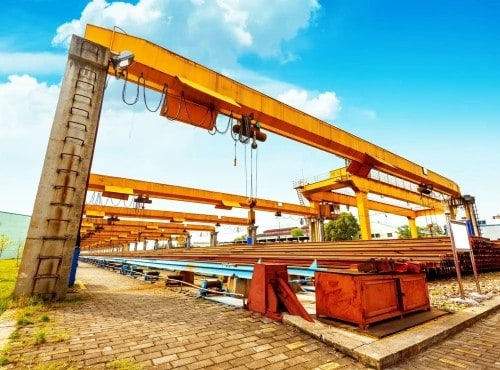According to the structure of the door frame, it is divided into gantry crane and cantilever gantry crane
Gantry crane
1. Full gantry crane: the main girder has no overhang, and the trolley is carried within the main span.
2. Semi-gantry crane: The outriggers have a height difference, which can be determined according to the civil engineering requirements of the site.
Cantilever Gantry Crane
1. Double cantilever gantry crane: The most common structural form, the force of the structure and the effective use of the site area are reasonable.
2. Single cantilever gantry crane: This structural form is often selected due to site constraints.
According to the main beam form
1. Single girder gantry crane
The single main girder gantry crane is simple in structure, easy to manufacture and install, and its own weight is small. Most of the main girder is a partial rail box frame structure. Compared with the double girder gantry crane, the overall rigidity is weaker. Therefore, this form can be used when the lifting capacity Q≤50t and the span S≤35m. There are two types of L-shaped and C-shaped gantry legs for single girder gantry cranes. The L-type is easy to manufacture and install, has a good stress condition, and its own mass is small, but the space for hoisting goods through the outriggers is relatively small. The C-shaped leg is made into an inclined or curved shape, and the purpose is to have a larger lateral space so that the goods can pass through the leg smoothly.
2. Double girder gantry crane
The double main girder gantry crane has strong bearing capacity, large span, good overall stability and many varieties, but its own quality is larger than that of the single main girder gantry crane with the same lifting capacity, and the cost is also higher. According to the structure of the main girder, it can be divided into two forms: box girder and truss. At present, box-shaped structures are generally used.
According to the main beam structure
1. Truss beam
The structural form welded by angle steel or I-beam has the advantages of low cost, light weight and good wind resistance. However, due to the many welding points and the defects of the truss itself, the truss beam also has the disadvantages of large deflection, low stiffness, relatively low reliability, and frequent inspection of welding points. It is suitable for sites with lower safety requirements and lower lifting capacity.
2. Box girder
The steel plate is welded into a box structure, which has the characteristics of high safety and high rigidity. It is generally used for large-tonnage and super-large-tonnage gantry cranes. As shown in the picture on the right, MGhz1200 is the largest gantry crane in China with a lifting capacity of 1,200 tons. The main girder adopts a box girder structure. The box girder also has the disadvantages of high cost, heavy weight, and poor wind resistance.
3. Honeycomb beam
Generally refers to “isosceles triangular honeycomb beam”, the end face of the main beam is triangular, there are honeycomb holes on the oblique belly on both sides, and there are chords on the upper and lower parts. Honeycomb girder absorbs the characteristics of truss girder and box girder, and has greater rigidity, smaller deflection and higher reliability than truss girder. However, due to the welding of steel plates, the self-weight and cost are slightly higher than those of truss beams. It is suitable for sites or beam yards that are frequently used or have heavy lifting capacity. Since this beam type is a patented product, there are fewer manufacturers.
by purpose
1. Ordinary gantry crane
This kind of crane mostly adopts box type and truss type structure, which is the most widely used. It can carry various pieces and bulk materials, with a lifting capacity of less than 100 tons and a span of 4 to 39 meters. Ordinary gantry cranes with grabs have a higher level of work. Ordinary gantry cranes mainly refer to hook, grab, electromagnetic, hoist gantry cranes, and also include semi-gantry cranes.
2. Gantry cranes for hydropower stations
It is mainly used for lifting and opening and closing gates, and can also be used for installation operations. The lifting capacity is 80-500 tons, the span is small, 8-16 meters; the lifting speed is low, 1-5 meters per minute. Although this kind of crane is not frequently lifted, once it is used, the work is very heavy, so the work level should be raised appropriately.
3. Shipbuilding gantry cranes
It is used to assemble the hull on the berth, and there are always two lifting trolleys: one has two main hooks, running on the track of the upper flange of the bridge; the other has a main hook and an auxiliary hook, which is on the lower flange of the bridge run on rails for flipping and hoisting large hull sections. The lifting capacity is generally 100-1500 tons; the span is up to 185 meters; the lifting speed is 2-15 meters per minute, and there is also a fretting speed of 0.1-0.5 meters per minute.
4. Container gantry crane
For container terminals. After the trailers transport the containers unloaded from the ship by the quay wall container carrier bridge to the yard or rear, they are stacked by the container gantry crane or directly loaded and transported away, which can speed up the turnover of the container carrier bridge or other cranes. The yard that can stack containers with a height of 3 to 4 layers and a width of 6 rows is generally of the tire type, but also of the rail type. Compared with the container straddle truck, the container gantry crane has a larger span and height on both sides of the portal frame. In order to meet the transportation needs of the port terminal, this kind of crane has a higher working level. The lifting speed is 8-10 meters per minute; the span is determined by the number of rows of containers that need to be crossed, and the maximum is about 60 meters, corresponding to the lifting capacity of 20 feet, 30 feet, and 40 feet long containers, which are about 20 tons and 25 tons respectively. and 30 tons.



















